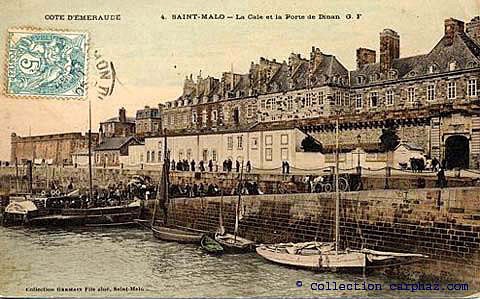Morrice Painting a Testament to his Appreciation of St. Malo

James Wilson Morrice (1865-1924), St. Malo (On the Ramparts), circa 1902. Oil on panel. 7 x 10 in. Sold by Alan Klinkhoff Gallery.
Brittany, at the end of the 19th century, had become a mecca for tourists attracted by its beaches; painters soon followed, attracted by the old city, its inhabitants, and...the beaches. Morrice visited Saint-Malo during his first summer in France, in 1890, and he returned many times after, especially between 1899 and 1904. He usually went in September, when the high tides attracted more bathers. Many sketches and canvases show the animated beaches at the foot of the old stone fortifications.
Dating from the Middle-Ages and reinforced in the 18th century, they encircle the old town. As suggested by the Baedeker guide, "Visitors should not omit to make the circuit of the town on the ramparts"; a century later, it is still the main attraction (Michelin gives it three stars). It is the best way to understand the town’s unique setting. Mainland, river Rance, outer harbour, open sea, beaches and inner port follow in that order to your left, if you go clockwise. The town itself, ending with the medieval Château, is always on your right. It burned down almost completely in 1944, but was rebuilt in the same style, so the view today is almost as Morrice saw it. And as I saw it myself...
We are still in the first leg of the rampart tour (going clockwise), overlooking the Quai de Dinan; the Porte de Dinan is below us. It was, and still is, the high tide docking spot for small excursion boats; when Morrice visited, the Dinard ferry also docked there, and he painted the red tip of a boat chimney behind the line of sheds. These wooden structures included a small waiting room for the ferry passengers, and the rest was used to store various equipment; it ended with an open yard. The Môle des Noire, the curved jetty with the small lighthouse, had not yet been extended to its present length, but was already quite impressing. At right, on the other side of the wall, two of the 18th century Corsair houses that lined the rue Saint-Philippe. The small town on the far shore is the station balnéaire Dinard; with a discreet patch of bare wood, the artist suggests its Plage de l’Ecluse and, with a tiny bright white brush stroke, he evokes the 45-meter tower adjoining the Hôtel Crystal.
On the top of the wall, two figures block our way, forcing us to join them in contemplating the view; the woman closer to us wears a “traditional” costume that marks her as “local”, perhaps visiting from a nearby town. A very subtle lightening of the black paint, and a more modern yellow (straw?) hat, belong to her companion. It is the end of the afternoon or early evening; the quay, on the south side of the old city, is already in the shade, but the last rays of the sun still illuminate the lighthouse and the sailboats, and of course the Crystal Tower in Dinard, directly West from us across the bay.
That’s a lot of subtle and delicate details on such a small surface, even if Morrice used a size larger than his preferred one. Did he really paint it on location? The point of view is too high for him, even standing, since the wall does not offer any higher point of view there. And this large panel would not really fit into his small paintbox, but another one would: a quick sketch of the same composition, likely painted on the spot. The rare composition, based on the receding wall (Morrice preferred to work with horizontals), is already there, but the schematized forms, including the slanted roofs of the sheds, and the reduced palette betray the rapidity of execution. Weather, perhaps a typical crachin breton (a drizzle) could be another factor... Morrice was the only soul on top of the wall that day.
Our panel was probably painted in a studio, perhaps in an hotel room, as I suggested for the Study for Regatta, Saint-Malo (see next paragraph). To help him with the details, the artist may have used a photo or a postcard like the one included here (fig 1), which clearly shows the small trees that grew at some point inside the open yard – other postcards show the yard with no trees, and later ones tell us that the sheds were demolished not long after 1905, and replaced by a row of small trees. In our Saint-Malo, Morrice has moved a shed facade to the side, but retained the small trees; he also moved the beach in Dinard towards the left. Most importantly, he “created” the two Breton onlookers, and made their day almost a sunny one. Dating a Morrice is difficult; his sketchbooks are useful, but we did not find any drawing relating to this particular view. However, two pages of his Sketchbook #5 show other views taken on top of the wall, further on in the clockwise tour (Montreal Museum of Fine Arts, Dr.1973.28, pages 40 and 56). This sketchbook also shows the excursion boat to Dinan – which Morrice boarded – docking at the Quai of the same name, therefore placing the artist near the present view. The Study for Regatta mentioned above is also probably based on a small sketch, not yet uncovered. It shows only the tip of the Môle des Noires, but the little figures in lower left stand on the quay, visible at the very bottom: the artist was clearly positioned on top of the wall, just a few meters further than the present view. I date that study ca 1902 for stylistic reasons, and because it might have been exhibited in December of that year (see Heffel Auction, 27 Nov. 2014, lot 149).

Fig 1. Postcard of St. Malo
The present panel, so close to it in many ways, probably dates from the same time (and not ca 1896-98, as I thought in 2007). No written document mentions a trip to Saint-Malo in late summer 1902, but nothing tells us that he was elsewhere: we ignore his whereabouts after mid-August, when he came back from Venice, and mid-December, when he sent a letter from Paris. A better proof is the two large canvases with Saint-Malo subjects he sent to the 1903 Salon de la Société Nationale in Paris, La Place Chateaubriand and Regatta, the latter based on the Study discussed here (both private collections). Sketchbook #5 was probably started there, and Morrice was still using it when he crossed the Atlantic the next June, since it also contains the drawing for En pleine mer (page 8; see Alan Klinkhoff Gallery: The Collection of Mitzi & Mel Dobrin, 2020, p. 191, for further details).
Copyright © Lucie Dorais, 2020
Complete Catalogue Details

James Wilson Morrice (1865-1924)
St. Malo (On the Ramparts), circa 1902
Oil on panel
7 x 10 ins
This work is included in the James Wilson Morrice Catalogue Raisonne compiled by Lucie Dorais, M.A.
Inscriptions
stamped 'STUDIO J.W. MORRICE' (recto); inscribed 'S/12 / $250.00 St. Malo' (recto, upper left)
Provenance
Private Collection of a Politician, Quebec
Walter Klinkhoff Gallery, Montreal
Collection of Michael Dunn, Vermont, USA, before 1977 to 2007
Masters Gallery, Calgary
Private Collection, Calgary
Alan Klinkhoff Gallery, 2021
Sold





Ajouter un commentaire